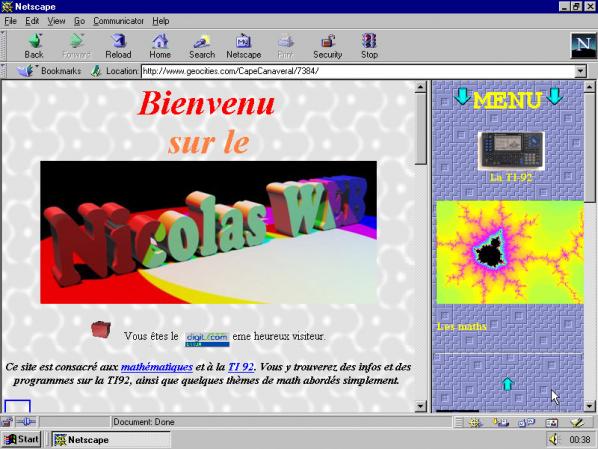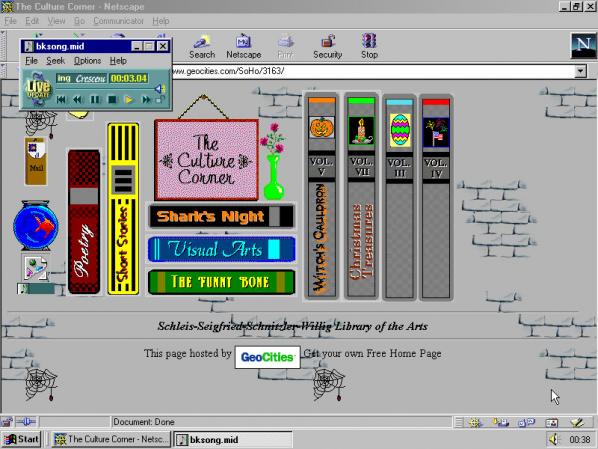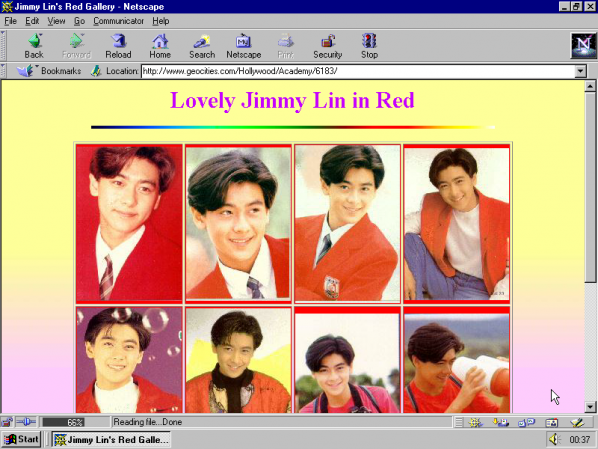



Featured image: A random Geocities homepage, last updated sometime around 1997
Daniel Rourke visits the Photographers’ Gallery in central London and reviews their latest exhibit One Terabyte of Kilobyte Age by artists Olia Lialina and Dragan Espenschied, on THE WALL. Over an eight week period (18 April – 17 June 2013) they feature a non-stop stream of video captures of what they term as the lost city and its archival ruins. A documentation of a past visual culture of the web and the creativity of its users with new pages changing every 5 minutes. The project provides a glimpse into web publishing when users were in charge of design and narration in contrast to the automated templates of Facebook, YouTube and Flickr.
Sifting through a dormant internet message board, or stumbling, awestruck, on a kippleised [1] html homepage, its GIF constellations still twinkling many years after the owner has abandoned them, is an encounter with the living, breathing World Wide Web. At such moments we are led, so argues Marisa Olson, ‘to consider the relationship between taxonomy à la the stuffed-pet metaphor and taxonomy à la the digital archive.’ [2] How such descript images, contrived jumbles of memory and experience, could once have felt so essential to the person who collated them, yet now seem so indecipherable, stagnant, even – dare we admit it – insane to anyone but the most hardened retro-web enthusiast.
On show at London’s Photographers gallery until June 17th is an extensive archival exhibit designed to manage, reveal and keep these experiences alive. One Terabyte Of Kilobyte Age (1tb) is the fifth work to be commissioned for the Photographer Gallery’s ‘The Wall’, curated by two artists long associated with the era of the web the exhibition reveres: Olia Lialina and Dragan Espenschied. Perhaps best known for their book Digital Folklore (2009) the artists and retro-web evangelists have, with the 1tb project, strengthened their status as archivists, an impulse Hal Foster famously argued ‘concerned less with absolute origins than with obscure traces’ [3]. In the same year that Dragan and Olia launched their guide to the folk web, Yahoo! announced they were to close one of its greatest sources of inspiration: Geocities. A vast expanse of personal webpages, many of which had long since slid into html decrepitude, represented for Yahoo! little but financial embarrassment. So ancient and outmoded was Geocities that many contemporary browsers were incapable of capturing its essence, fragmenting images and link rolls randomly across modern laptop screens in an attempt to render their 800×600 pixel aura. Scraping and downloading the terabyte or so of data that made up the Geocities universe was thought important enough by some that a taskforce was put together, made up of technical wizards and wizardesses driven by the profound notion that all existent culture is worth saving. From Olia and Dragan’s webpage:
In between the announcement and the official date of death a group of people calling themselves Archive Team — managed to rescue almost a terabyte of Geocities pages. On the 26th of October 2010, the first anniversary of this Digital Holocaust, the Archive Team started to seed geocities.archiveteam.torrent.
Olia and Dragan’s gesture, to feed the wealth of culture contained in that torrent back to the masses in a palatable form, is a project whose fruition at the Photographer’s Gallery is but a minor part. After downloading, storing and sorting the 16,000 archived Geocities sites the task of exactly how to display them is a problem. Since most browsers would mangle the look and feel of the Geocities pages Olia and Dragan have turned to two main methods of re-representation. The first, let loose on an automated Tumblr blog that updates over 70 times a day, is an ever growing series of front-page screen captures. In this form 1tb bends to the will of a contemporary web user who concerns themselves with likes, reposts and uplinks.
Reflecting on the Tumblr-archive of the torrent-archive of the Geocities-archive, Olia and Dragan’s site contemporary-home-computing highlights particular screen captures that have garnered the most reposts and likes from their Tumblr followers. The results say much for the humour that still drives online culture, but perhaps little about the original contexts from whence those screen captures came. For instance, the screen captures that garner most attention are usually the ones that have failed a part of the retrieval/display/capture process. These ‘obscure traces’ may be GIF heavy sites, half loaded to interesting aesthetic affect, or, perhaps the most telling, captures that show nothing but the empty shell of a Netscape Navigator browser, caught forever like a millennium bug in digital amber.

The second mode of capture and re-display takes place at the Photographer’s Gallery itself. Depicted on nine large intersecting HD video screens set into ‘The Wall’ of the entrance-cum-café, one’s first experience of the exhibit is ponderous. The display cycles through the vast array of Geocities homepages at five minute intervals, giving viewers a more than generous dose of 800×600 px nostalgia. Whether the websites that fade into view are a barrage of animated GIFs,insightful commentary on life in the late 1990s, or a series of barren ‘Under Construction’ assemblages, is up to chance.
As a reviewer, sent to derive something from the gallery experience, the wall leered at me with gestures that sent my inner taxonomist into a frenzy. Confronted with such tiny slithers of the archive, in such massive doses, it quickly becomes obvious that the real potential of the project has not been quite realised. Rather than static screen captures The Wall shows cleverly rendered quicktime videos, allowing the GIF whiskers of a Hello Kitty mascot to quiver once more. If you are lucky, or have the patience to watch a long series of the sites fade into view, you’ll be greeted by flickering ‘Welcome’ banners, by cartoon workmen tirelessly drilling, by unicorns cantering and sitemeter bars flashing. But The Wall also feels wholly at odds with its content, caught up in a whirl of web nostalgia that minimises the lives, experiences and aesthetic choices of a defining generation to static flashes that you can’t click on, no matter how much you want to. Archives are living, breathing entities wont to be probed for new meanings and interpretations. Whether depicted as static or faux animated, One Terabyte Of Kilobyte Age is a project with an endless surface, with little way for its viewers to delve deeper.

Trawling through the 1tb Tumblr is a much more visceral experience than the one that greets you at the Photographer’s Gallery, but the sense of a journey waiting to be embarked on is lost somewhat in the move to the Tumblr kingdom. Every five minutes offers a new chance to spot similarities on The Wall, to ponder on the origins of a site or, more profoundly, wonder where the people that toiled to make them are now. Before the days of user driven content, of Facebook timelines, and even before RSS feed aggregators, the whole web felt something like this. Today’s web is unarguably more dynamic, with a clean aesthetic that barely shifts behind the waves of content that wash over its surface. But the user has been relegated to shuffler of material.
The Geocities homepage was designed, and kept updated by an army of amateur enthusiasts, organising bandwidth light GIFs in ever more meaningful arrays, in the unlikely event that another living soul would stumble upon them. There is much to love about One Terabyte Of Kilobyte Age, and much to be learned from it given the time. But part of me wishes that the Photographer’s Gallery had given over their trendy café to a row of beige Intel 486 computer stacks, their unwieldy tube monitors better capturing the spirit of the web alá 1996. The clash between the 90s amateur enthusiast and the avid content shuffler of the 2010s is inherent in the modes of display Olia and Dragan chose for their project. Beginning from a desire to save and reflect on our shared heritage, 1tb now represents itself as pure content. An impulse to probe the archive replaced by an impulse to scroll endlessly through Tumblr streams, clicking like buttons on screen captures we hope will distract/impress/outrage our friends until the next cat video refreshes into view.
Go, go to the Photographer’s Gallery tomorrow, grab yourself a coffee and let the Geocities archive wash over you. If you can do it without Instagramming a snap to your friends, without updating your Facebook page with tales of your nostalgic reverie, if you can let the flickering screen captures do their own talking , only then can you claim you truly re-entered the kilobyte age.
